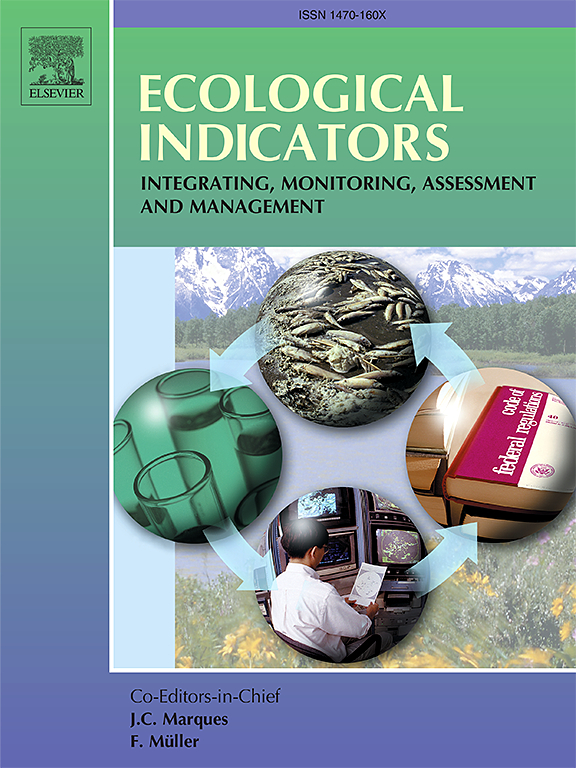结合野外采样反映干旱区生物多样性保护功能
IF 7
2区 环境科学与生态学
Q1 ENVIRONMENTAL SCIENCES
引用次数: 0
摘要
生物多样性是实现多项可持续发展目标不可或缺的组成部分,但全球变化威胁着其在人类世的保护。虽然栖息地质量(HQ)已成为大规模生物多样性保护的广泛采用指标,但准确量化相同土地利用类型的栖息地质量变化仍然具有挑战性。通过在InVEST-HQ模块中整合具有野外数据(植物生物量和生物多样性指数)的复合环境指数,开发了一个增强模型,实现了1990 - 2022年新疆旱地生态系统时空HQ的稳健评估。结果表明,修正后的模型精度显著提高,森林的相关系数(实际测量值与评价值之间的相关系数)从0.1提高到0.58,草原的相关系数从0.3提高到0.76。InVEST-HQ模型对总部变化的敏感性有限,NDVI改善的总部对总部的评价存在生境类型限制。HQ趋势的比较分析揭示了不同建模方法的不同模式。原始的InVEST-HQ模型在研究区域显示出最小的时间变化和轻微的退化,而ndvi修正的结果在研究区域显示出明显的增加。修正后的HQ在平原地区呈下降趋势,在山区呈上升趋势。改进后的方法对灌木林、草地和城市生态系统的总指挥部(13.9%)、总指挥部(5.7%)和总指挥部(13.7%)有显著改善,对森林生态系统的总指挥部(- 4.5%)有显著下降。通过结合特定区域的环境参数,我们的框架可以可靠地捕捉到人类主导的景观(如城市/农业区)的总部动态,为脆弱干旱地区的生态保护提供现实的决策和数据支持。本文章由计算机程序翻译,如有差异,请以英文原文为准。
Incorporating field sampling to reflect biodiversity protection function in arid region
Biodiversity is integral to achieving multiple Sustainable Development Goals, yet global change threatens its preservation in the Anthropocene. While habitat quality (HQ) has emerged as a widely adopted metric for large-scale biodiversity conservation, accurately quantifying HQ changes across same land use types remains challenging. We developed an enhanced model by integrating a composite environmental index with field data (plant biomass and biodiversity index) into the InVEST-HQ module, enabling robust spatiotemporal HQ assessment in Xinjiang’s dryland ecosystems from 1990 to 2022. The findings showed that our modifications significantly improved model accuracy, with the correlation coefficient (between actual measurement and evaluation values) increasing from 0.1 to 0.58 in forests and 0.3 to 0.76 in grasslands. InVEST-HQ model showed limited sensitivity to HQ changes, and HQ improved by NDVI exhibited habitat type limitations for HQ assessments. The comparative analysis of HQ trends revealed distinct patterns across modeling approaches. While the original InVEST-HQ model showed minimal temporal variation with slight degradation in the study area, a NDVI-modified result exhibited a marked increment in the area. The HQ modified in this study decreased for plains and increased for mountain areas. Our modified method expresses significant improvement in shrubland HQ (13.9%), grassland HQ (5.7%) and urban HQ (13.7%) and marked decline in forest ecosystems (−4.5%). By incorporating region-specific environmental parameters, our framework reliably captures HQ dynamics even in human-dominated landscapes (e.g., urban/agricultural areas), offering realistic decision-making and data support for ecological conservation in fragile arid.
求助全文
通过发布文献求助,成功后即可免费获取论文全文。
去求助
来源期刊

Ecological Indicators
环境科学-环境科学
CiteScore
11.80
自引率
8.70%
发文量
1163
审稿时长
78 days
期刊介绍:
The ultimate aim of Ecological Indicators is to integrate the monitoring and assessment of ecological and environmental indicators with management practices. The journal provides a forum for the discussion of the applied scientific development and review of traditional indicator approaches as well as for theoretical, modelling and quantitative applications such as index development. Research into the following areas will be published.
• All aspects of ecological and environmental indicators and indices.
• New indicators, and new approaches and methods for indicator development, testing and use.
• Development and modelling of indices, e.g. application of indicator suites across multiple scales and resources.
• Analysis and research of resource, system- and scale-specific indicators.
• Methods for integration of social and other valuation metrics for the production of scientifically rigorous and politically-relevant assessments using indicator-based monitoring and assessment programs.
• How research indicators can be transformed into direct application for management purposes.
• Broader assessment objectives and methods, e.g. biodiversity, biological integrity, and sustainability, through the use of indicators.
• Resource-specific indicators such as landscape, agroecosystems, forests, wetlands, etc.
 求助内容:
求助内容: 应助结果提醒方式:
应助结果提醒方式:


